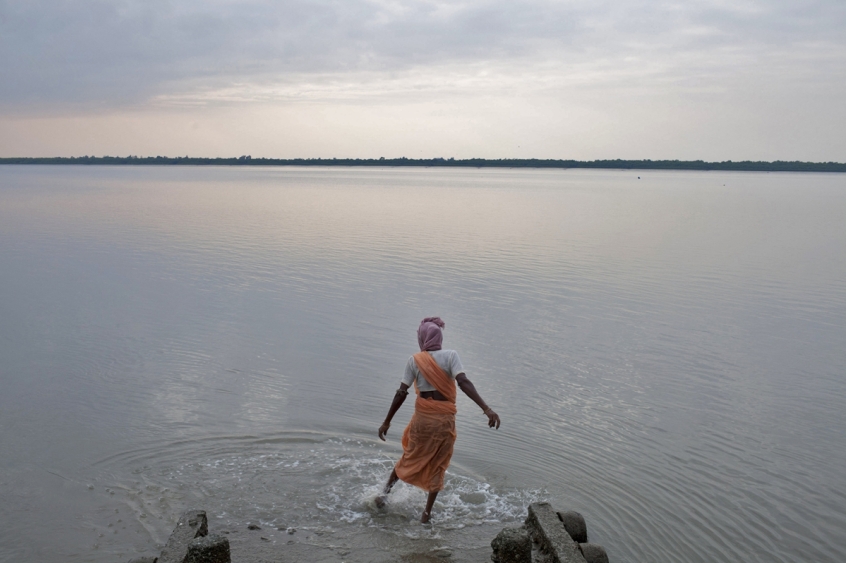
Andrew Hogg is head of media at Christian Aid. The charity has just launched a new interactive story The Tiger, the fisherman, his wife and our future which tells the story of the delicate balancing act between humankind, animal and the climate in this fragile part of the world.
Amid the lush islands and sparkling inlets of the Ganges Delta, where three of Asia's mightiest rivers pour into the Bay of Bengal, one deadly, decisive factor holds human expansion in check.
The region, the Sundarbans, is home to some four million people but the sea, its level rising because of climate change, is steadily reclaiming the land – more than 100 square kilometres have disappeared in the past 30 years.
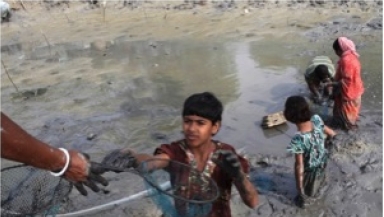
The snaggle-toothed coastline, the site of the largest mangrove forest in the world, is hugely fertile. Some 300,000 people there struggle to earn a living, but further human encroachment on the forest is not an option.
For the mangroves are the haunt of the Royal Bengal tiger, a protected species which, faced with the same pressure on its habitat as local villagers, poses an ever present threat.
Attacks on humans are so frequent – with tigers even leaping into fishing boats – that today there are few people living close to the shore who have not known a victim. Tiger widows are commonplace, survivors bearing the scars of a mauling rather rarer, but not unknown.
The spectre of sudden death has prompted many young men to migrate miles away for work rather than risk their lives eking out a living in traditional Sundarbans style -fishing, hunting crabs, subsistence farming or collecting honey.
The human cost of government determination to protect the tiger population is high, but the inhabitants of the city of Kolkata some 60 miles away have good reason to be thankful for their presence.
Were it not for the tigers, say conservationists, much of the mangrove forest which absorbs the worst of the cyclones and storm surges that in recent years have grown in frequency and intensity, would have vanished.
The trees would have been uprooted by villagers hungry for land to farm, leaving Kolkata and its almost five million residents hugely vulnerable to extreme weather and storm surges sweeping in from the ocean.
The city is already at risk from climate change. Last year the Intergovernmental Panel on Climate Change, one of the world's most authoritative voices on the impact of carbon emissions, warned Kolkata would in the next few decades become one of those in Asia most in danger of serious flooding.
The tigers, says Dr Sugata Hazra, Director of Oceanographic Studies at the city's Jadavpur University, help prevent that prospect becoming a reality now.
The impact of climate change is already making itself felt, he says. The monsoon rainfall pattern has changed, with an increase in the intensity and number of cyclones, and the sea level is rising faster than the global average.
"All the agricultural land in the Sundarbans has come at the expense of the forest," says Dr Hazra. "The mangroves are a huge carbon sink, on a par with the Amazonian rain forest. What protects them now is the presence of the tigers."
Mr Joydip Kundu, general secretary of the Society for Heritage and Ecological Research shares that view. "It's like a chain," he says. "The tiger is protecting the mangrove eco system. And the mangroves act as a shield against cyclones.
"It is because of the Sundarbans mangrove shield that the entire south of Bengal is safe. It is fear of the tigers which keeps people out of the forests. The tiger is the sole protector of everything. The moment you take the tiger out of the landscape, the entire ecosystem will vanish."
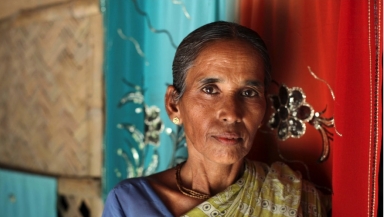
Minati Roy was a newly married woman in her twenties with two young sons when her husband was snatched 15 years ago while collecting honey. She had experienced a feeling of foreboding all day.
Before venturing into the mangroves, her husband had prayed at the shrine of a local deity, Banbibi, a guardian spirit of the forests particularly venerated by honey-collectors and woodcutters in West Bengal for protection against tiger attacks.
"All the boatmen who go to collect honey visit her temple first," said Minati, now aged 42. "He was attacked later as the men moved between the honeycombs. On that day I was not in a good mood. Some unexpected occurrence or bad news was going to come to my heart, I could predict it.
"They couldn't bring his body back. They could only bring back his beedi (cigarette) box, gas lighter and sickle."
Minati keeps any bitterness she may feel at the sudden turn that her life took to herself. "The tigers are protecting the forest" she says expressionlessly. "When we ask the authorities why we need these forests, they explain that if there are no forests, no trees, there would be no life."
Her one son who is able to earn a living she has sent away to work. "Here there is no other work than the forest. If he wants to stay then he would have to go on a boat to catch fish like his father or collect crab and honey. That is why I have sent him to Kolkata," she explains.
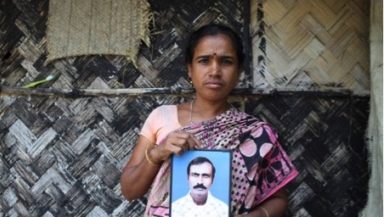
Sabitri Mondal, aged 30, who husband was attacked and killed two years ago tells a similar story. Her son was just 13 when he left to work in Kolkata.
"When the tiger carried my husband away he called for help saying he was still alive. My son didn't want to catch fish here after his father's accident."
But Avijit Dhali, aged 23, the only breadwinner in his family, says he has no other option than to try to earn a living in the manner of his father, a fisherman killed five years ago.
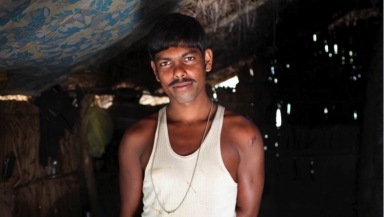
"I am a fisherman. It's my only means of livelihood. We have to live, and the main occupations of people in this area are fishing and crab collecting. There is no alternative," he says.
"I am in constant fear while going fishing but I have no choice. So I go with 3-4 men and come back, but the fear in me stays."
His mother Laxmi, aged 44, worries constantly. "After my husband was killed I couldn't educate my children. I had to stop the education. I don't feel like sleeping unless and until my son returns home after being out. Sometimes I even walk on the road to see whether he is coming," she says.
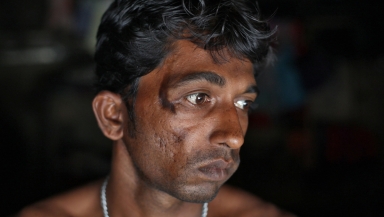
Anath Seal, aged 33, has lost two close relatives to tiger attacks, and is lucky to be alive himself. The first attack, in 2002, claimed the life of his nephew Santosh.
"When the tiger came running I had a stick in my hand which I used to hit him. The more I hit, the more he was trying to attack me" he says, one eye framed by a livid scar.
"I hit the tiger twice with the stick but it broke. I had nothing in my hand and standing there. The tiger was salivating in front of me. Next he gave me a slap on the side and then he caught me with both paws.
"When the tiger left I carried Santosh in my arms. I was staring at the tiger and telling him you can't take two of us. Today I am defeated but one day I will see you, I was saying in my mind."
A few years later Anath was collecting crabs close to the river with his brother in law: "Suddenly my brother-in-law called me. I saw that a tiger had attacked him and he had fallen into the water. I could see bubbles. Only the tail of the tiger was visible.
"I was speechless. I could not cry for help. Suddenly the tiger and my relative arose from the waters. The tiger was still holding my brother-in-law in his mouth, and carried him away."
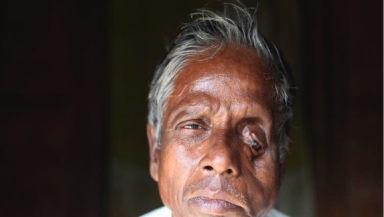
As he was seized, Rabi Majumdar, aged 63, tried to re-enact a folk-story his father had told him about an old woman who poked a crocodile in the eye. "As the tiger jumped he caught hold of my head and pulled me backwards. The whole world became dark.
"When the tiger was taking me away I thought of the story of the woman. I could not see anything as my head was inside the tiger's mouth.
"I used my hand to push the tiger but couldn't. Next I used my other hand to push the face of the tiger. But my hand touched the palate of the mouth and then the tiger left me. I got up. I could not see anything. I still don't have vision in one eye."
Mr Amal Nayek, director of the Champa Mahila Society which aims at creating a self-reliant community, particularly in the fields of education and health, says that out of 104 islands in the delta, 48 are inhabited, the others are forest.
He laments the hardship endured by the tiger widows. "Their lives become very terrible, very pathetic," he says. "They cannot send their children to school, to supply food for their children.
"But if the Sundarbans are lost, we will be lost also. We want to make the people understand that the Sundarbans is the protector of other districts. Our slogan is: Save the Sundarbans, save the tigers of the Sunderban and save the people of the Sunderban."
Christian Aid is helping poor communities adapt to climate change. As well as helping communities to develop sustainable ways to feed their families, Christian Aid campaigns at a regional, national and international level to ensure decision makers take action.
To find out more visit 'The tiger, the fisherman, his wife and our future'

















